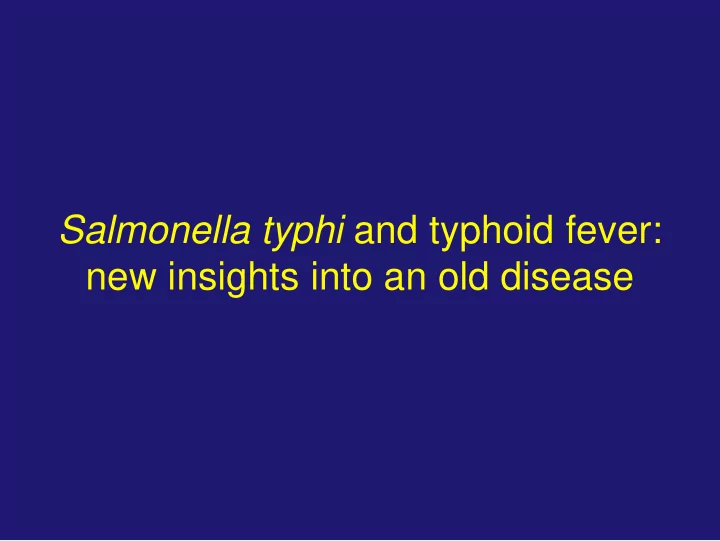

Salmonella typhi and typhoid fever: new insights into an old disease
Two fundamental questions about Salmonella Typhi: • Why it causes typhoid fever? • Why it only causes disease in humans?
Cytolethal distending toxin Pertussis toxin Song et al, Nature (2013)
Song et al, Nature (2013)
Two fundamental questions about Salmonella Typhi: • Why it causes typhoid fever? because S. Typhi ( and S. Paratyphi) encodes “typhoid toxin”, which is responsible for the pathognomonic symptoms of typhoid fever and is absent from non-typhoidal Samonellae • Why it only causes disease in humans?
Two fundamental questions about Salmonella Typhi: • Why it causes typhoid fever? because S. Typhi encodes “typhoid toxin”, which is responsible for the pathognomonic symptoms of typhoid fever and is absent from non-typhoidal Samonellae • Why it only causes disease in humans?
Host restriction is manifested at the cellular level: Salmonella typhi does not survive within mouse macrophages S. Typhimurium S. Typhi Spano & Galan, PNASc (2012); Science (2013)
Expression of single Salmonella Typhimurium gene, gtgE , allows Salmonella Typhi to overcome host restriction in mouse macrophages ( in vitro ) and mouse tissues ( in vivo ) mouse macrophages mouse spleens S. Typhi + gtgE S. Typhimurium S. Typhi Spano & Galan, PNASc (2012); Science (2013)
Salmonella type III secretion system: a molecular machine for protein delivery into host cells
GtgE extends host range by proteolytically removing Rab29, Rab32, and Rab38 from the Salmonella-containing vacuole Typhi Tm = Rab29/32/38 GtgE
Rab29, Rab32, and Rab38 localize to the human-adapted S. typhi and S. paratyphi -containing vacuoles but not to vacuoles harboring S. typhimurium
Rab32/Rab38 delivers antimicrobial factors to the Salmonella - containing vacuole in macrophages
Removal of Rab32 allows Salmonella typhi survival in mouse macrophages and tissues RNAi-mediated depletion in macrophages S. typhi in spleens of infected mice Spano & Galan, Science (2013)
Two fundamental questions about Salmonella Typhi: • Why it causes typhoid fever? because S. Typhi (and S. Paratyphi) encodes “typhoid toxin”, which is responsible for the pathology and symptoms of typhoid fever • Why it only causes disease in humans? because in non-permissive animals S. typhi replication is restricted by macrophages through a Rab32-dependent pathway, which broad host Salmonellae neutralize by targeting Rab32 with the effector protein GtgE (absent from S. typhi and S. paratyphi)
T yphoid toxin recognizes terminally sialylated glycans on specific specific surface glycoproteins (Podocalixin 1 and CD45) on target cells Song et al, Nature (2013)
Two major sialic acids in mammalian cells: Humans CMAH (cytidine monophospho-N- acetylneuraminic acid Other mammals hydroxylase) (pseudogene in humans)
Typhoid toxin binds Neu5Ac- but not Neu5Gc- terminated glycans Deng et al, Cell (in press)
Typhoid toxin does not bind to chimpanzee cells Deng et al, Cell (in press)
Typhoid toxin binds to human but not to chimpanzee tissues small intestine spleen Deng et al, Cell (in press)
Constitutive expression of cmah renders mice completely resistant to typhoid toxin Deng et al, Cell (in press)
Two fundamental questions about Salmonella Typhi: • Why it causes typhoid fever? because S. Typhi (and S. Paratyphi) encodes “typhoid toxin”, which is responsible for the pathology and symptoms of typhoid fever • Why it only causes disease in humans? because in non-permissive animals S. typhi replication is restricted by macrophages through a Rab32-dependent pathway, which broad host Salmonellae neutralize by targeting Rab32 with the effector protein GtgE (absent from S. typhi and S. Paratyphi)) Furthermore, disease can only occur in humans because they are the only species that uniquely express Neu5Ac-terminated glycans, which are the receptors for typhoid toxin, while other mammals predominantly express Neu5Gc-terminated glycans, which are not permissive for typhoid toxin binding
Stefania Jeongmin Former members: Erik Haghjo Spano Song Juan Ugalde Xiang Gao Ajit Varki’s group David Smith &Jamie Heimburg-Molinaro Consortium for functional glycomics UCSD Emory University
Recommend
More recommend